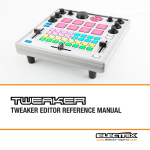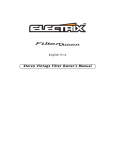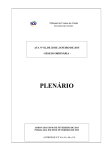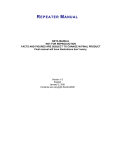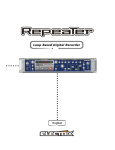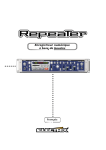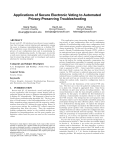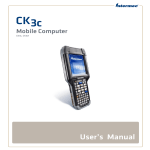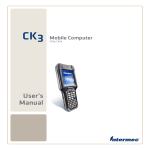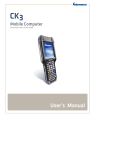Download TWEAKER USER MANUAL
Transcript
TWEAKER USER MANUAL WWW.ELECTRIXPRO.COM ELECTRIX TWEAKER User Manual Table of Contents 1 Getting Started 1.1Introduction 1.2 What‘s Included in the Box? 1.3 Product Registration 1.4 Height Extension Legs 1.5 Overlay Installation 1.6 Firmware & Utilities 2Connections 2.1USB 2.2 MIDI In 2.3 MIDI Out 3 Hardware Controls 3.1Buttons 3.2Encoders 3.3 LED’s (Button Indicators) 3.4 LED Rings 3.5 Pressure Sensitive Pads 3.6Potentiometers 4 Default MIDI Settings 5 The Settings Channel 5.1 Encoder Settings 5.2 LED Ring Settings 6 SysEx Messages 6.1 System Exclusive Command Bytes 2 4 4 4 5 5 5 6 8 8 8 8 9 9 11 13 15 18 19 22 24 55 28 32 32 ELECTRIX TWEAKER User Manual 6.2 6.3 6.4 Set Messages Request Responses Message Glossary 32 39 40 Safety Instructions liquid has been spilled or objects have fallen into the apparatus, the apparatus has been exposed to rain or moisture, does not operate normally, or has been dropped. Read these instructions. Keep these instructions. Heed all warnings. Follow all instructions. Do not use the apparatus near water. Clean only with dry cloth. Use in accordance with the manufacturer’s instructions. Do not use near any heat sources such as radiators, heat registers, stoves, or other apparatus (including amplifiers) that produce heat. Please keep the unit in a well ventilated environment. WARNING To reduce the risk of fire or electric shock, do not expose this apparatus to rain or moisture. The apparatus shall not be exposed to dripping or splashing and that no objects filled with liquids, such as vases, shall be placed on the apparatus. Protect the USB cord from being walked on or pinched particularly at plugs, convenience receptacles, and the point where they exit from the apparatus. Only use attachments/ accessories specified by the manufacturer. CAUTION To reduce the risk of electric shock, do not remove any cover. No user-serviceable parts inside. Refer servicing to qualified service personnel only. Refer all servicing to qualified service personnel. Servicing is required when the apparatus has been damaged in any way, such as damaged connectors, 3 1. Getting Started 1 Getting Started Thank you for purchasing the TWEAKER on behalf of the entire Electrix team. We hope you enjoy performing with the TWEAKER as much as we enjoyed making it! 1.1Introduction TWEAKER is a universal controller that offers lots of options for customization, but for those who want to get started right away, we included mappings and overlays for popular programs like Traktor and Ableton. For those of you who like to dig a little deeper, the included TWEAKER EDITOR lets you customize settings and save your own presets for use with a variety of software applications. This manual also contains lots of useful information on default settings, SysEx used by TWEAKER, and the Settings Channel, which is used to send MIDI messages back to TWEAKER to change settings on-the-fly. 4 1. Getting Started 1.2 What’s Included in the Box? The TWEAKER box contains the following items: The TWEAKER Controller A set of four height-extension legs A USB cable A Quick Start poster An installation CD including: Traktor 2 LE, TWEAKER EDITOR software, and the Ableton Live Remote Script 8 An overlay for the included Traktor 2 LE software 8 An overlay for the included Ableton Live Remote Script 8 8 8 8 8 1.3 Product Registration Why not take a few minutes to register your new product? Registration enables us to keep a record of your product in case you ever need assistance or warranty coverage. It also enables us to keep you up to date on any software or firmware updates, availability of new mappings or overlays, etc. In some cases, additional content may also be available for registered users. To register your product, visit www.electrixpro.com and click on the Register/Login link at the right corner of the site. 1.4 Height Extension Legs A set of four legs is included to extend the height of the TWEAKER to match traditional DJ gear. With the legs installed, TWEAKER is the same height as most DJ turntables. The legs screw directly into the bottom surface of the TWEAKER using the provided screw-holes. 1.5 Overlay Installation To place an overlay on the TWEAKER, simply remove the three fader knobs and place the overlay on the face plate, making sure that it is tightly fitted in the corners and around all the controls. 5 1. Getting Started The TWEAKER enclosure was designed to keep overlays in place with minimal movement during performances. 1.6 Firmware & Utilities The TWEAKER’s firmware updates via USB. Firmware updates may become available from time to time. Visit www.electrixpro.com to register your product and sign up to receive TWEAKER updates. 1.6.1 Checking Current Firmware Version You can check your current firmware version at any time by holding the three buttons down indicated on the image below, simultaneously: While these three buttons are held down, the firmware version will be indicated on the bottom encoder LED rings on both mixer channels. The left LED ring indicates the number before the decimal point, and the right LED ring indicates the number after the decimal point. For example, to indicate version 4.3, four LED’s will light up on the left ring, and three LED’s will light up on the right ring. 6 1. Getting Started 1.6.2 Updating Firmware 1. Hold down the round rubber button located in the center of the four directional navigation buttons, while connecting Tweaker to your computer, 2. A volume named TweakerDisk will mount on your system, 3. Drag the Tweaker firmware binary file and drop it onto the TweakerDisk volume, 4. The velocity pads will flash while the firmware is updating. Do not disconnect the USB cable during this process, 5. It is safe to disconnect the USB once the pads have stopped flashing. Once the update is complete you must reconnect the TWEAKER to return to normal operating mode. 1.6.3 LED Test To test the LED’s, hold down button the large navigation encoder push button while connecting Tweaker to your computer. All LED’s will light up. Press it again to exit and return to normal operating mode. 7 2. Connections 2Connections Any of the controls on TWEAKER can be configured to provide a wide range of functionality. Here are some basic terms and uses for the controls. 2.1USB The USB port connects to your computer to send and receive MIDI message, update the firmware, and power the unit. This port is available to your software as Tweaker Port 1. 2.2 MIDI In The MIDI Input port provides a standard 5 PIN MIDI jack to connect other MIDI devices to TWEAKER. MIDI input data is then routed over USB to the host computer, and is available to your software on the second port named “Tweaker Port 2.” 2.3 MIDI Out The MIDI Output port provides a standard 5 PIN MIDI jack for outputting MIDI from your computer, over the USB cable, and to the MIDI jack. TWEAKER will also send its data from the MIDI Out jack. This MIDI Output can be accessed on your computer via the port named “Tweaker Port 2.” 8 3. Hardware Controls 3 Hardware Controls Any of the controls on the TWEAKER can be configured to provide a wide range of functionality. Here are some basic terms and uses for the controls. 3.1Buttons The TWEAKER has 7 encoder push buttons and 43 custom-designed, soft-touch rubber buttons. All button parameters can be controlled using the TWEAKER EDITOR software. The specific MIDI messages that the TWEAKER recognizes are also detailed below. Most music programs are designed to use momentary buttons. For this reason, the TWEAKER’s buttons are momentary: they send a Note On message when pressed, and a Note Off message when released. This is similar to the way piano keys operate. 9 3. Hardware Controls 3.1.2Mappability Each button can be mapped to output Notes or CC’s. Each button may also function as a speed control button for the encoders (detailed below). The assignment of each button may be modified using the TWEAKER EDITOR or the ‘Set Button Mapping’ SysEx. Note/ CC Each button can be mapped to any note (0-127) and any CC (0-119). Multiple buttons can be mapped to output to the same Note/ CC, but only one indicator LED can receive feedback on that Note/CC. Each button has its own individual output channel. The TWEAKER outputs a 127 ‘ON’ and 0 ‘OFF’ velocity when mapped as a Note or a CC. Default Settings Soft-touch buttons are mapped to Notes 1-43 Encoder push buttons are mapped to Notes 44-50 All buttons operate on MIDI Channel 1 Speed Control Button The TWEAKER’s encoders are capable of increasing or decreasing their value at 2 assignable encoder speeds. Any button may be mapped as a ‘Speed Control Button’ to toggle between these two speeds. By default, the encoders increase values at about the same rate as a potentiometer, and a little over a 3/4 turn achieves a full MIDI range of 0-127. This is encoder speed ‘5’. When you switch to the default alternate speed for fine control with the speed control button, each click of the encoder increments one value. At this speed, you need four full turns of the encoder to achieve a full MIDI range of 0-127. 3.1.3 LED Feedback All of the TWEAKER’s rubber buttons and pads are backlit by LED’s. Each LED can be controlled by its respective button’s current state (on/off ). By default, Button Local Control of LED’s is disabled because it can interfere with software MIDI feedback. All button indicator LED’s can also be controlled by incoming MIDI Messages. By default, all button indicator LED’s have the same mapping as their respective buttons. This makes TWEAKER compatible with most music software that use MIDI feedback by default. 10 3. Hardware Controls 3.2Encoders The TWEAKER has 7 encoders. Each encoder is capable of outputting in Absolute or Relative Mode. The output mode of each encoder can be adjusted using the TWEAKER EDITOR, the Settings Channel, or using the “Set Encoder Output Modes” SysEx. 3.2.1 Absolute Mode When in Absolute Mode, an encoder outputs very much like an ordinary potentiometer. By default, the six channel strip encoders are in Absolute Mode. Absolute mode is generally used to control effects, EQ settings, and other continuous parameters. As you turn clock-wise, the encoder will output increasing values until it outputs 127. As you turn counter clock-wise, the encoder will output decreasing values until it outputs 0. If Local Control of the LED rings in is enabled, the ring will update the display the current value of the encoder. Local Control for encoders in Absolute Mode can be controlled using the TWEAKER EDITOR or the Ring Local Control feature of the Settings Channel. Encoder Speeds The angle of turn needed to complete a full 0-127 sweep on an encoder is dependent on the declared encoder speed. This is a global control. The default speed is 5, and the default alternate speed is 1. At a Speed of 5, the Encoder changes value at about the same rate as a potentiometer. At a Speed of 1, the encoder’s natural speed, an encoder changes value at 1 value per encoder click/detent (about one quarter of the rate of a potentiometer). Maximum Encoder Speed is 7, and Minimum Speed is 1. The TWEAKER stores 2 encoder speeds at a time, and they can be toggled between using a Speed Control Button. 11 3. Hardware Controls Encoder speeds are assignable by the TWEAKER EDITOR’s “encspeedA” and “encspeedB” functions, by sending a message to an encoder on the Settings Channel, or using the “Set Encoder Speeds” SysEx Message. MIDI Feedback Encoders in Absolute Mode accept standard MIDI Feedback. If the TWEAKER receives a message with the same mapping as an encoder, it will use the value of that message to set the current value of the encoder. For example, If the message “CC57, value 127, on Channel 1” is received by a TWEAKER with default settings, it will update its stored value for the top-left encoder to 127. If Ring Local Control is enabled, the LED Ring will update the display the current value of the encoder. MIDI Feedback Loops In order to eliminate feedback loops that could lock an encoder at a value, the TWEAKER will ignore a MIDI message that is mapped to an encoder that is actively being turned by the user. This is especially helpful for TRAKTOR’s feedback system, which will send a message right back to the TWEAKER after receiving it in some cases. The TWEAKER can still accept messages that are mapped to the LED Ring that accompanies that encoder during this period if Ring Local Control for encoders in Absolute Mode is disabled. 3.2.2Relative The TWEAKER’s encoders can also operate in Relative Mode. This version of relative mode is known as “2’s Compliment.” When in Relative Mode, an encoder outputs continuously in either direction. Relative Mode is generally used to cycle through long lists, adjust track position, and other incremental adjustments that require more than the traditional 0-127 output. By default, the large navigation encoder is in Relative Mode. The TWEAKER only outputs two messages in Relative Mode: 8 Clockwise: +1 ( velocity/ value 1 ) 8 Counter-Clockwise: -1 ( velocity/ value 127 ) One message is output for each click of the encoder (increment or decrement). There are approximately 30 increments in one full rotation of an encoder. If Ring Local Control in Relative Mode is enabled, the LED Ring will update to show the direction of the encoder’s last turn. Ring Local Control in Relative Mode can be controlled using the Local Control feature of the Settings Channel. 12 3. Hardware Controls MIDI Feedback Encoders in Relative Mode are capable of accepting MIDI feedback to the LED Rings. If the TWEAKER receives a message with the same mapping as an LED Ring, the TWEAKER will use that message to set the current display of the LED Ring based on the LED Ring’s Display Mode and the value of the message. If Ring Local Control in Relative Mode is disabled, software applications capable of sending scaled feedback to one of these LED rings can display absolute-style feedback to your TWEAKER for controls that you are modifying with an encoder in Relative Mode. 3.2.3Mappability Note/ CC Messages Each encoder can be mapped to output to any CC (0-119) using the TWEAKER EDITOR or the “Set Encoder Mappings” SysEx. Multiple encoders can be mapped to output to the same Note/ CC, but only one will be able to receive direct feedback via MIDI message in this case. Each encoder has it’s own individual output channel that can be changed using the TWEAKER EDITOR. 3.3 LED’s (Button Indicators) The TWEAKER has a total of 57 button indicator LED’s: 38 RGB LED’s, 13 red monochrome LED’s, and 6 blue monochrome LED’s for the encoder push buttons. 3.3.1 Reception Modes The LED’s are capable of responding to Note / CC MIDI messages as well as button presses. Note/ CC LED mappings follow the mapping of the corresponding buttons or pads. By remapping the matched button or pad, each LED can be mapped to respond to any Note (0-127) and any CC (0115) using the TWEAKER EDITOR or the “Map Buttons” SysEx Messages. Each RGB LED has it’s own individual reception channel and mapping, which is independent of the button mapping. Each monochrome LED shares its individual reception channel with the corresponding button. 13 3. Hardware Controls Default Settings 8 8 8 8 8 The RGB LED’s are mapped to Notes 1-38 The Red LED’s used for the navigation style buttons are mapped to Notes 39-43. The Red LED’s used for pressure sensitive pads are mapped to Notes 63-70. The Blue LED’s to indicate encoder push button activity are mapped to Notes 45-50. All LED’s are mapped to MIDI Channel 1 Button Local Control These Button Indicator LED’s can also be locally controlled. In other words, they can light in reaction to a Button’s Current State, but only if the Button Local Control is enabled for the Button. Button Local Control can be turned on and off in the TWEAKER EDITOR’s Global Settings, or by CC Message using the ‘Local Control’ feature of the Settings Channel (See Chapter 6 for details). 14 3. Hardware Controls 3.3.2 Display Styles RGB LED’s There are 38 RGB (Red/Green/Blue) LED’s: 32 for the grid and three per channel strip. They have eight states: 8 000-000: Off 8 001-003: Green 8 004-007: Red 8 008-015: Yellow 8 016-031: Blue 8 032-063: Cyan 8 064-126: Magenta 8 127-127: White Monochromatic LED’s There are 13 red monochrome LED’s and 6 blue monochrome LED’s. They have two states: 8 000-063: LED Turns Off 8 064-127: LED Turns Solid On 3.4 LED Rings There are three LED rings per mixer channel strip. Each LED Ring is composed of 13 red LED’s. 3.4.1 Reception Modes An LED ring’s display can be controlled by incoming Note / CC MIDI messages and the by the encoder it surrounds. By default, encoders are in Absolute Mode, and the LED rings display the current value of the encoder. An LED ring also updates when the TWEAKER receives a MIDI message that matches its mapping. Note/ CC Messages LED Ring mappings can be modified using the TWEAKER EDITOR, or the “Set LED Ring Map” SysEx message. When the TWEAKER receives an LED ring-directed message, the LED ring is updated as determined by its display mode and message velocity/value. These messages do not affect the 15 3. Hardware Controls encoder value. Default Settings The LED Rings are mapped to CC79-84 on MIDI Channel 1. Encoder Local Control By default, the LED rings are locally controlled by the encoders. Locally controlled encoders can update the LED rings when: 8 User turns the encoder, or 8 TWEAKER receives a MIDI message (also known as a feedback message) that matches the mapping of the encoder. 3.4.2 Display Modes The LED rings have four modes to accurately display the current state of any function. The display mode of each LED ring can be set using the TWEAKER EDITOR, by using the “Set LED Display Mode” SysEx, or by basic Note / CC Messages, using the LED rings feature of the Settings Channel. Walk Walk mode lights 1 LED at a time and seemingly walks up as encoder’s value increases. This mode has 14 states, so the visual resolution of each state is about 9 MIDI values. Fill Fill mode lights all preceding LED’s as encoder’s value increases. This Mode has 14 States, so the visual resolution of each state is about 9 MIDI values. 16 3. Hardware Controls EQ EQ mode lights from the center LED and stretches either to the left or right depending on the LED ring’s display value. When the LED ring’s display value reaches 0, the LED’s on the left side will all be lit. When the LED ring’s display value reaches 127, the LED’s on the right side will all be lit. This mode has 13 states, so the visual resolution of each state is about 10 MIDI Values. This mode is good for parameters that are centered around MIDI value 63-64, such as EQ and pan. By default, the LED rings are in EQ mode. Spread Spread mode lights the rings from the center LED out to both edges. This Mode has 8 states, so the visual resolution of each state is about 15 MIDI Values. This display mode is especially effective for resonance (width) controls of parametric EQ’s. Relative Relative Mode is used only for relative encoder local control, and cannot be specially assigned. It has five states; still, incrementing, incrementing (alternate), decrementing, and decrementing (alternate). Dual Display LED rings are capable of responding to incoming MIDI messages, and being controlled by encoder movements at the same time. You may, for example, have your software stream the current track’s output level on CC79 (the top-left LED Ring). You may also have that encoder at CC57 controlling the fader volume for the track. In this example, when you turn the encoder, the LED ring will temporarily allow the encoder value to display on the LED ring. When you finish turning, the TWEAKER will release the control of the LED ring back to the MIDI stream of the current track’s level. 17 3. Hardware Controls 3.5 Pressure Sensitive Pads The TWEAKER has 8 large pressure sensitive pads for drumming or expressive control of effects. 3.5.1 Modes of Output Each pad is capable of outputting in Note messages upon press and release (like a keyboard), to trigger drums or play melodies. Each pad can also stream CC messages of the current value while the pad is depressed, so you can use your favorite software modulate LFO’s or perform bends on the notes after trigger. The output modes and the Note and CC mappings of each pad can be adjusted using the TWEAKER EDITOR or the “Pressure Sensitive Pad Settings” SysEx. 3.5.2 Pad Trigger and Return Values The Pressure at which a Pad Generates a Note On message (and starts streaming CC messages) is customizable. Similarly the pressure at which a pad generates a Note Off message (and stops streaming CC messages) is also customizable using the Trigger and Return features of TWEAKER EDITOR or the “FSR Settings” SysEx message 3.5.3 Pad Sensitivity The amount of pressure required to reach the maximum velocity (127) is also customizable. At the maximum sensitivity of 5, maximum value is easily achieved and value increases quickly with increasing pressure. Whereas at a sensitivity of 0, value increases slowly with increasing pressure. The default sensitivity is 4. Pad sensitivity can be adjusted using the TWEAKER EDITOR or the “Force Sensitive Pad Settings” SysEx message. 18 3. Hardware Controls 3.5.4 Pad CC Retrigger Rate The pads are capable of outputting CC’s at a predefined rate in multiples of 5 milliseconds (ms). By default, this rate is 45ms. It can be modified using the TWEAKER EDITOR or the “Force Sensitive Pad Settings” SysEx message. 3.5.5Mappability Each pad can output Notes and CC’s. The Note mapping acts like a normal keyboard key, with a Note On message of a velocity proportional to the force of the hit when the pad is struck. The TWEAKER outputs a Note Off message when the pad is released. The CC output reacts like a potentiometer. While a pad is depressed, the TWEAKER will stream with a value proportional to the force at which the pad is pressed. The assignment of each Note and CC mapping may be modified using the TWEAKER EDITOR or the “Set Button Mapping” SysEx. The CC Output may be disabled using TWEAKER EDITOR or the “Pressure Sensitive Pad Settings” SysEx. Note/ CC Each button can be mapped as any Note (0-127) and any CC (0-119). Multiple pads can be mapped to output to the same Note/ CC, but only one LED can receive feedback on that Note/CC. Each pad has it’s own individual output channel. Default Settings The pads are mapped to Notes 63-70 and CC’s 71-78. The indicator LED for each pad is controlled by the pad’s Note mapping. All pads are mapped to MIDI Channel 1. 3.6Potentiometers The TWEAKER has a total of five potentiometers: two rotary pots, two vertical sliders, and a crossfader. All pots operate in Absolute Mode, which is useful for controlling volume, gain, or other continuous parameters. As you turn clockwise (or slide upward), the pot will output increasing values until it outputs 127. As you turn counter clockwise (or slide downward), the pot will output decreasing values until it outputs 0. Center Note Messages The rotary and vertical sliders have a center detent, which are capable of outputting MIDI Note messages. The TWEAKER outputs the following Note messages by default: 19 3. Hardware Controls 8 Potentiometer reaches center: TWEAKER sends note off (velocity 0) 8 Potentiometer leaves center (increasing) TWEAKER sends note on velocity 127 8 Potentiometer leaves center (decreasing): TWEAKER sends note on velocity 64 These messages were designed so that a tweaker’s potentiometer can naturally turn off filters and effects when it reaches center value, or have a different effect or function assigned to each half of the pot. 20 3. Hardware Controls 3.6.1Mappability CC Messages Each potentiometer can be mapped to output to any CC (0-119) using the TWEAKER EDITOR or the “Set Potentiometer Mappings” SysEx. Multiple pots can be mapped to output to the same CC. Each encoder has it’s own individual output channel that can be changed using the TWEAKER EDITOR. Center Note Messages Each potentiometer’s center note message is mapped to the same note as it’s cc mapping. For example, by default the left channel strip slider outputs channel 1, CC 53. Similarly, the center note message for that slider outputs channel 1, note 53. Default Settings Rotary potentiometers are mapped to CC/Notes 51-52 Vertical sliders are mapped to CC/Notes 53-54 Crossfader is mapped to CC 55 All pots are mapped to MIDI Channel 1 21 4. Default MIDI Settings 4 Default MIDI Settings The following is a list of the TWEAKER’s factory default MIDI note and CC settings. Soft Touch Buttons Force Sensitive Pads Mapping: MIDI Notes 1-38 MIDI Channel: 1 No Speed Control Buttons Enabled Mapping: MIDI Notes 63-70 Mapping: MIDI CC’s 71-78 MIDI Channel: 1 No Speed Control Buttons Enabled q RGB LED’s Mapping: MIDI Notes 1-38 MIDI Channel: 1 Auto-light (Local Control): Off q Red LED’s (Force Sensitive Pad Indicators) Mapping: MIDI Notes 63-70 MIDI Channel: 1 Auto-light (Local Control): Off Soft Touch Navigation Buttons Rotary Encoders Mapping: MIDI Notes 39-43 MIDI Channel: 1 No Speed Control Buttons Enabled Mapping: MIDI CC’s 56-62 MIDI Channel: 1 Encoder Speed1: 5 Encoder Speed2: 1 Output Mode: Absolute Mode (except Navigation Encoder which is in Relative Mode) q Red LED’s (Navigation Button Indicators) Mapping: MIDI Notes 39-43 MIDI Channel: 1 Auto-light (Local Control): Off q LED Rings Mapping: MIDI CC’s 79-84 MIDI Channel: 1 Encoder Link: On Ring Mode: EQ Mode Encoder Push Buttons Mapping: MIDI Notes 44-50 MIDI Channel: 1 No Speed Control Buttons Enabled q Blue LED’s (Encoder Push Button Indicators) Mapping: MIDI Notes 44-50 MIDI Channel: 1 Auto-light (Local Control): Off General MIDI Local Control: Off Omni Channel: Off External MIDI Jacks: Enabled Potentiometers (Includes Faders) Mapping (normal output): MIDI CC’s 51-55 Mapping (Center-Note): MIDI Notes 51-54 MIDI Channel: 1 22 4. Default MIDI Settings D#1 BUTTON: A1 ENCODER: CC 57 RING: CC 79 BUTTON: G#1 ENCODER: CC 56 F#1 E1 POT: BUTTON: C2 ENCODER: CC 60 RING: CC82 G1 POT: F1 CC 51 CC 52 CENTER NOTE: CENTER NOTE: D#2 BUTTON: A#1 ENCODER: CC 58 RING: CC80 E2 NOTE: NOTE: NOTE: NOTE: AFTERTOUCH: AFTERTOUCH: AFTERTOUCH: AFTERTOUCH: D#3 E3 CC 71 BUTTON: B1 ENCODER: CC 59 RING: CC81 CC 72 F#3 CC 73 CC 74 BUTTON: D2 ENCODER: CC 62 RING: CC 84 NOTE: NOTE: NOTE: NOTE: AFTERTOUCH: AFTERTOUCH: AFTERTOUCH: AFTERTOUCH: G3 A0 F3 G#3 CC 75 A3 CC 76 A#3 CC 77 CC 78 A#0 C#-2 D-2 D#-2 E-2 F-2 F#-2 G-2 G#-2 A-2 A#-2 B-2 C-1 C#-1 D-1 D#-1 E-1 F-1 F#-1 G-1 G#-1 A-1 A#-1 B-1 C0 POT: CC 53 F2 C1 C#1 POT: CENTER NOTE: BUTTON: C#2 ENCODER: CC 61 RING: CC 83 CC 54 C#0 D0 D#0 F0 E0 F#0 G0 G#0 B0 CENTER NOTE: F#2 D1 CC 55 TWEAKER DEFAULT MIDI MAP (Blank maps are available online in pdf format) 23 5. The Settings Channel 5 The Settings Channel The settings channel is reserved for the use of standard MIDI CC messages to configure different TWEAKER settings. Send a CC number on this channel to the TWEAKER and, if it matches the CC number mapping for an LED ring or an encoder, the value will change its properties. The following properties can be modified using the settings channel: 8 Encoder speed 8 Encoder mode (absolute/relative) 8 LED rings display style 8 Local Control (CC# 122) The tables below describe each bit in the 7-bit value of the MIDI CC message for the Encoders, LED Rings, and Local Control. It is these combinations of bits that determine the final value of the CC message. Encoders Position Name MSB LSB Position 7 6 5 4 3 2 1 0 Descriptor xMIDIx SB EOM1 EOM0 ES3 ES2 ES1 ES0 Value 0 1 1 1 1 1 0 0 LED Rings Position Name MSB LSB Position 7 6 5 4 3 2 1 0 Descriptor xMIDIx SB ALD ELD RM3 RM2 RM1 RM0 Value 0 1 1 1 1 1 0 0 Local Control Local Control Position Name MSB Position 7 6 5 4 3 2 1 LSB 0 Descriptor xMIDIx SB BTN BTNT ENCA ENCR ANA x Value 0 0 0 0 0 0 0 0 24 5. The Settings Channel 4RM = Ring Mode 4SB = Security Bit (0 = ignore message, 1=accept message) 4ES = Encoder Speed 4EOM0 = Encoder Output Mode (0=absolute,1=relative 4EOM1 <reserved> 4ENCR = Encoder Relative Local Control 4ENCA = Encoder Absolute Local Control 4ANA = Analog Local Control 5.1 Encoder Settings 5.1.1 Default Settings Settings Channel: 16 Encoder Mappings: Min: CC56 Max: CC62 5.1.2 Encoder Response Table Value Received by Tweaker Expected Change to Encoder Properties Ring Mode Encoder Output Mode Encoder Speed (global) 0-63 <nc> <nc> <nc> 64 Fill Relative <nc> 65 Walk Relative <nc> 66 EQ Relative <nc> 67 Spread Relative <nc> 68 Fill Absolute <nc> 69 Walk Absolute <nc> 70 EQ Absolute <nc> 71 Spread Absolute <nc> 72 Fill Relative 1 25 5. The Settings Channel 73 Walk Relative 1 74 EQ Relative 1 75 Spread Relative 1 76 Fill Absolute 1 77 Walk Absolute 1 78 EQ Absolute 1 79 Spread Absolute 1 80 Fill Relative 2 81 Walk Relative 2 82 EQ Relative 2 83 Spread Relative 2 84 Fill Absolute 2 85 Walk Absolute 2 86 EQ Absolute 2 87 Spread Absolute 2 88 Fill Relative 3 89 Walk Relative 3 90 EQ Relative 3 91 Spread Relative 3 92 Fill Absolute 3 93 Walk Absolute 3 94 EQ Absolute 3 95 Spread Absolute 3 96 Fill Relative 4 97 Walk Relative 4 98 EQ Relative 4 99 Spread Relative 4 100 Fill Absolute 4 101 Walk Absolute 4 102 EQ Absolute 4 103 Spread Absolute 4 26 5. The Settings Channel 104 Fill Relative 5 105 Walk Relative 5 106 EQ Relative 5 107 Spread Relative 5 108 Fill Absolute 5 109 Walk Absolute 5 110 EQ Absolute 5 111 Spread Absolute 5 112 Fill Relative 6 113 Walk Relative 6 114 EQ Relative 6 115 Spread Relative 6 116 Fill Absolute 6 117 Walk Absolute 6 118 EQ Absolute 6 119 Spread Absolute 6 120 Fill Relative 7 121 Walk Relative 7 122 EQ Relative 7 123 Spread Relative 7 124 Fill Absolute 7 125 Walk Absolute 7 126 EQ Absolute 7 127 Spread Absolute 7 Sample Messages CC 56, Channel 16, Velocity 64 Puts the large navigation encoder in Relative Mode CC 56, Channel 16, Velocity 63 No change to the large navigation encoder 27 5. The Settings Channel CC 57, Channel 16, Velocity 68 Puts the top-left encoder in Absolute Mode Puts the top-left encoder’s LED ring in Fill Mode No change to encoder speed CC 57, Channel 16, Velocity 69 Puts the top-left encoder in Absolute Mode Puts the top-left encoder’s LED ring in Walk Mode No change to encoder speed CC 57, Channel 16, Velocity 70 Puts the top-left encoder in Absolute Mode Puts the top-left encoder’s LED ring in EQ Mode No change to encoder speed CC 57, Channel 16, Velocity 71 Puts the top-left encoder in Absolute Mode Puts the top-left encoder’s LED ring in Spread Mode No change to encoder speed 5.2 LED Ring Settings 5.2.1 Default Settings Default Settings Channel: 16 Default LED Ring Mappings: Min: CC79 Max: CC84 28 5. The Settings Channel 5.2.2 LED Rings Response Table Value Received by Tweaker Expected Change to Encoder Properties Ring Mode Encoder Output Mode Encoder Speed (global) Encoder Local Control of LED Rings 0-63 <nc> <nc> <nc> <nc> 64 Fill <nc> <nc> enabled 65 Walk <nc> <nc> enabled 66 EQ <nc> <nc> enabled 67 Spread <nc> <nc> enabled 68 Fill <nc> <nc> enabled 69 Walk <nc> <nc> enabled 70 EQ <nc> <nc> enabled 71 Spread <nc> <nc> enabled 72 Fill <nc> <nc> enabled 73 Walk <nc> <nc> enabled 74 EQ <nc> <nc> enabled 75 Spread <nc> <nc> enabled 76 Fill <nc> <nc> enabled 77 Walk <nc> <nc> enabled 78 EQ <nc> <nc> enabled 79 Spread <nc> <nc> enabled 80 Fill <nc> <nc> enabled 81 Walk <nc> <nc> enabled 82 EQ <nc> <nc> enabled 83 Spread <nc> <nc> enabled 84 Fill <nc> <nc> enabled 85 Walk <nc> <nc> enabled 86 EQ <nc> <nc> enabled 87 Spread <nc> <nc> enabled 88 Fill <nc> <nc> enabled 29 5. The Settings Channel 89 Walk <nc> <nc> enabled 90 EQ <nc> <nc> enabled 91 Spread <nc> <nc> enabled 92 Fill <nc> <nc> enabled 93 Walk <nc> <nc> enabled 94 EQ <nc> <nc> enabled 95 Spread <nc> <nc> enabled 96 Fill <nc> <nc> disabled 97 Walk <nc> <nc> disabled 98 EQ <nc> <nc> disabled 99 Spread <nc> <nc> disabled 100 Fill <nc> <nc> disabled 101 Walk <nc> <nc> disabled 102 EQ <nc> <nc> disabled 103 Spread <nc> <nc> disabled 104 Fill <nc> <nc> disabled 105 Walk <nc> <nc> disabled 106 EQ <nc> <nc> disabled 107 Spread <nc> <nc> disabled 108 Fill <nc> <nc> disabled 109 Walk <nc> <nc> disabled 110 EQ <nc> <nc> disabled 111 Spread <nc> <nc> disabled 112 Fill <nc> <nc> disabled 113 Walk <nc> <nc> disabled 114 EQ <nc> <nc> disabled 115 Spread <nc> <nc> disabled 116 Fill <nc> <nc> disabled 117 Walk <nc> <nc> disabled 118 EQ <nc> <nc> disabled 119 Spread <nc> <nc> disabled 30 5. The Settings Channel 120 Fill <nc> <nc> disabled 121 Walk <nc> <nc> disabled 122 EQ <nc> <nc> disabled 123 Spread <nc> <nc> disabled 124 Fill <nc> <nc> disabled 125 Walk <nc> <nc> disabled 126 EQ <nc> <nc> disabled 127 Spread <nc> <nc> disabled Sample Messages CC 79, Channel 16, Velocity 68 No change to encoder output mode Puts the top-left encoder’s LED ring in Fill Mode No change to encoder speed Ring Local Control is ‘enabled’ and encoders can control LED rings (This modifies same variable as sysex 11 ‘Disable Encoder Local Control’) CC 79, Channel 16, Velocity 100 No change to encoder output mode Puts the top-left encoder’s LED ring in Fill Mode No change to encoder speed Ring Local Control is ‘disabled’ and encoders cannot control LED rings (This modifies same variable as sysex 14 ‘Disable Encoder Local Control’) 31 6. SysEx Messages 6 SysEx Messages The following is a list of the TWEAKER’s factory default MIDI note and CC settings. 6.1 System Exclusive Command Bytes The System Exclusive message includes the official MIDI Manufacturer ID for ELECTRIX, a Product number, and the Command number. Each command is described in the following sections. 240, 0, 1, 106, 1, NN, ..., 247 The ELECTRIX identification number is 6A The TWEAKER product number is 01 The Command number is NN Note: All numbers in this specification are Base-10 (Decimal) numbers unless otherwise noted. 6.2 Set Messages These messages allow you to change the settings of the TWEAKER. 01 : Button Mappings This Message changes the MIDI mapping (Channel, Note/CC, and Number). Total Bytes: Data Bytes: Data Bytes per Button: 1st Data Byte Received: 2nd Data Byte Received: 107 100 2 Mapping Number Channel Number/ Output Type Special Cases: Encoder Speed Control Button Output Type = 1 Mapping Number = 127 32 6. SysEx Messages Message for Default Settings: < 240, 00, 01, 106, 01, 01, 00, 01, 00, 02, 00, 03, 00, 04, 00, 05, 00, 06, 00, 07, 00, 08, 00, 09, 00, 10, 00, 11, 00, 12, 00, 13, 00, 14, 00, 15, 00, 16, 00, 17, 00, 18, 00, 19, 00, 20, 00, 21, 00, 22, 00, 23, 00, 24, 00, 25, 00, 26, 00, 27, 00, 28, 00, 29, 00, 30, 00, 31, 00, 32, 00, 33, 00, 34, 00, 35, 00, 36, 00, 37, 00, 38, 00, 39, 00, 40, 00, 41, 00, 42, 00, 43, 00, 44, 00, 45, 00, 46, 00, 47, 00, 48, 00, 49, 00, 50, 247 > 02 : Potentiometer Mappings This message changes the MIDI mapping of all potentiometers (Channel, Note/CC, and Number). Total Bytes: 19 Data Bytes: 12 Data Bytes per Pot: 2 1st Data Byte Received: Mapping Number 2nd Data Byte Received: Channel Number/ Output Type Message for Default Settings: < 240, 00, 01, 106, 01, 02, 00, 51, 00, 52, 00, 53, 00, 54, 00, 55, 247 > 03 : Encoder Mappings This message changes the MIDI mapping of all encoders (Channel, CC Only, and Number). Total Bytes: 21 Data Bytes: 14 Data Bytes per Encoder: 2 1st Data Byte Received: Mapping Number 2nd Data Byte Received: Channel Number/ Output Type 33 6. SysEx Messages Message for Default Settings: < 240, 00, 01, 106, 01, 03, 00, 56, 00, 57, 00, 58, 00, 59, 00, 60, 00, 61, 00, 62, 247 > 04 : Force Sensitive Pad Mappings This message changes the MIDI mapping of all 8 force sensitive pads (Channel, Notes (CC’s), and Number). Total Bytes: 21 Data Bytes: 14 Data Bytes per Pad: 4 (2 sets of 2) 1st Data Byte Received: Mapping Number 2nd Data Byte Received: Channel Number/ Output Type Special Cases: In this message, the first 16 data bytes designate the Note On/ Note Off mappings for the pads. The second 16 data bytes designate the CC (Retriggering) mappings. Message for Default Settings: < 240, 00, 01, 106, 01, 04, 00, 63, 00, 64, 00, 65, 00, 66, 00, 67, 00, 68, 00, 69, 00, 70, 00, 71, 00, 72, 00, 73, 00, 74, 00, 75, 00, 76, 00, 77, 00, 78, 247 > 05 : Encoder Settings This Message changes all of the settings for all encoders. 1st Data Byte Received: Encoders Absolute/ Relative 2nd Data Byte Received: Encoder Speed A 3rd Data Byte Received: Encoder Speed B Total Bytes: 10 34 6. SysEx Messages Data Bytes: 3 Data Bytes per Encoder : Not Applicable Message for Default Settings: < 240, 0, 1, 106, 01, 05, 126, 05, 01, 247 > 06 : FSR Settings This message changes all settings for all pads. 1st Data Byte Received: CC Retrigger On (Force Sensitive Pads 1-7) 2nd Data Byte Received: CC Retrigger On (Force Sensitive Pad 8) 3rd Data Byte Received: Note On Pressure Threshold (Low) 4th Data Byte Received: Note On Pressure Threshold (High) 5th Data Byte Received: Note Off Pressure Threshold (Low) 6th Data Byte Received: Note Off Pressure Threshold (High) 7th Data Byte Received: CC Resend Rate 8th Data Byte Received: Force Sensitive Pad Sensitivity Total Bytes: 10 Data Bytes: 3 Data Bytes per Pad: Not Applicable Message for Default Settings: < 240, 00, 01, 106, 01, 06, 127, 127, 15, 00, 07, 00, 09, 5, 247 > 35 6. SysEx Messages 07 : LED Ring Output Modes This Message changes the display mode of all LED rings (Walk, Fill, Spread, or EQ). Total Bytes: 9 Data Bytes: 2 LED Rings per Data Byte: 3 Bits per LED Ring: 2 1st Data Byte Received: LED Rings 1-3 (Bitwise: x 0 r3h r3l | r2h r2l r1h r1l ) 2nd Data Byte Received: LED Rings 4-6 (Bitwise: x 0 r4h r4l | r5h r5l r6h r6l ) Valid Output Modes: 0: Fill 1: Walk 2: EQ 3: Spread Message for Default Settings (All EQ Mode): < 240, 0, 1, 106, 01, 07, 42, 42, 247 > 08 : Map RGB LED’s This Message changes the MIDI mapping of all RGB LED’s (Channel, CC Only, and Number). Total Bytes: 83 Data Bytes: 76 Data Bytes per RGB LED: 2 1st Data Byte Received: Mapping Number 2nd Data Byte Received: Channel Number/ Output Type Message for Default Settings: < 240, 00, 01, 106, 01, 08, 0, 1, 0, 2, 0, 3, 0, 4, 0, 5, 0, 6, 0, 7, 0, 8, 0, 9, 0, 10, 0, 11, 0, 12, 0, 13, 0, 14, 0, 15, 0, 16, 0, 17, 0, 18, 0, 19, 0, 20, 0, 21, 0, 22, 0, 23, 0, 24, 0, 25, 0, 26, 0, 27, 0, 28, 0, 29, 0, 30, 0, 31, 0, 32, 0, 33, 0, 34, 0, 35, 0, 36, 0, 37, 0, 38, 247 > 36 6. SysEx Messages 09 : Map LED Rings This message changes the MIDI mapping of all LED rings (Channel, CC Only, and Number). Total Bytes: 19 Data Bytes: 12 Data Bytes per LED Ring: 2 1st Data Byte Received: Mapping Number 2nd Data Byte Received: Channel Number/ Output Type Message for Default Settings: < 240, 00, 01, 106, 01, 09, 0, 79, 0, 80, 0, 81, 0, 82, 0, 83, 0, 84, 247 > 13 : Set Settings Channel This Message changes the Settings Channel. Total Bytes: 8 Data Bytes: 1 1st Data Byte Received: MIDI Channel 0 = MIDI Channel 1 15 = MIDI Channel 16 Message for Default Settings Channel (MIDI Channel 16): < 240, 0, 1, 106, 01, 13, 15, 247 > 37 6. SysEx Messages 14 : Disable Encoder Local Control This message can enable or disable Ring Local Control for the encoders. Total Bytes: 8 Data Bytes: 1 1st Data Byte Received: Local Control Disabled? 0 = Enabled 1+ = Disabled Message for Default Settings (Enabled): < 240, 0, 1, 106, 01, 14, 0, 247 > 15 : Disable Potentiometer Center Note Messages This message can enable or disable the Note On and Off messages that are sent by the potentiometer when the control enters and leaves the center detent. Total Bytes: 8 Data Bytes: 1 1st Data Received: Byte Local Control Disabled? 0 = Enabled 1+ = Disabled Message for Default Settings (Enabled): < 240, 0, 1, 106, 01, 15, 0, 247 > 126 : Request Controller Configuration This Message asks the TWEAKER to send a return message detailing all of its settings. Total Bytes: 8 Data Bytes: 0 Message to Request Settings: < 240, 0, 1, 106, 01, 126, 247 > 38 6. SysEx Messages 127 : Save Maps and Settings The TWEAKER saves all of its current settings as the default settings when it receives this message. User settings will be stored in flash memory and automatically restored whenever it is powered up. Message to Save Settings: < 240, 0, 1, 106, 01, 127, 247 > 6.3 Request Responses 125 : Acknowledgement The TWEAKER sends this message any time it receives a valid SysEx message. Total Bytes: 7 Data Bytes: 0 Response: < 240, 0, 1, 106, 01, 125, 247 > 39 6. SysEx Messages 126 : Receive Controller Configuration The TWEAKER sends this message in response to a Request Controller Configuration Message. Total Bytes: 108 Data Bytes: 101 Default Settings Response: < 240, 0, 1, 106, 1, 126, Button Map: 0, 1, 0, 2, 0, 3, 0, 4, 0, 5, 0, 6, 0, 7, 0, 8, 0, 9, 0, 10, 0, 11, 0, 12, 0, 13, 0, 14, 0, 15, 0, 16, 0, 17, 0, 18, 0, 19, 0, 20, 0, 21, 0, 22, 0, 23, 0, 24, 0, 25, 0, 26, 0, 27, 0, 28, 0, 29, 0, 30, 0, 31, 0, 32, 0, 33, 0, 34, 0, 35, 0, 36, 0, 37, 0, 38, 0, 39, 0, 40, 0, 41, 0, 42, 0, 43, 0, 44, 0, 45, 0, 46, 0, 47, 0, 48, 0, 49, 0, 50, Pot/Fader Map: 0, 51, 0, 52, 0, 53, 0, 54, 0, 55, Encoder Map: 0, 56, 0, 57, 0, 58, 0, 59, 0, 60, 0, 61, 0, 62, FSR Map CCs: 0, 63, 0, 64, 0, 65, 0, 66, 0, 67, 0, 68, 0, 69, 0, 70, FSR Map Notes: 0, 71, 0, 72, 0, 73, 0, 74, 0, 75, 0, 76, 0, 77, 0, 78, Encoder Settings: 126, 5, 1, FSR Settings: 1, 127, 15, 0, 7, 0, 9, 4, Local Control Flags: 4, Settings Channel: 15, LED Ring Mode: 42, 42, LED Map: 0, 1, 0, 2, 0, 3, 0, 4, 0, 5, 0, 6, 0, 7, 0, 8, 0, 9, 0, 10, 0, 11, 0, 12, 0, 13, 0, 14, 0, 15, 0, 16, 0, 17, 0, 18, 0, 19, 0, 20, 0, 21, 0, 22, 0, 23, 0, 24, 0, 25, 0, 26, 0, 27, 0, 28, 0, 29, 0, 30, 0, 31, 0, 32, 0, 33, 0, 34, 0, 35, 0, 36, 0, 37, 0, 38, LED Ring Map: 0, 79, 0, 80, 0, 81, 0, 82, 0, 83, 0, 84, 247 > 6.4 Message Glossary Mapping Number This Designates the CC or Note Number assigned to the Control. Notes Min: 0 Max: 127 CC’s: Min: 0 Max: 120 40 6. SysEx Messages Channel Number/ Output Type Bitwise: x c3 c2 c1 c0 m2 m1 m0 Note or CC (m2:m0) : Min: 0 (Note) Max: 1 (CC) Values 2-7 can be sent but are invalid states. MIDI Channel (c3:c0): Min: 0 (MIDI Channel 1) Max: 15 (MIDI Channel 16) Encoders Absolute/ Relative This Data Byte determines whether each encoder outputs in Absolute Mode or Relative (2’s Compliment Mode). Bitwise: x e7 e6 e5 e4 e3 e2 e1 e0 Bits per Encoder: 1 0 = Absolute Mode 1 = Relative Mode Default: 1 (0x01) Large navigation encoder [e0] outputs in Relative Mode, all other encoders output in Absolute Mode. Encoder Speeds A and B These Data Bytes determine how much encoders increment per click. Min: 1 (Value Increments by 1 for each click) Max: 15 (Value Increments by 15 for each click) 41 6. SysEx Messages Defaults: Speed A: 5 Speed B: 1 CC Retrigger On This pair of Bytes determines whether or not each pressure sensitive pad will stream CC messages of a value related to the current pressure while the pad is depressed. Bits per Pad: 1 0 = CC Retriggering Disabled 1 = CC Retriggering Enabled Default: 0 (for each Pad) 1st Byte Received: Force Sensitive Pads 1-7 Bitwise: x p7 p6 p5 p4 p3 p2 p1 2nd Byte Received: Force Sensitive Pad 8 Bitwise: x x x x x x x p8 Note On/ Off Pressure Threshold Note On pressure threshold determines how hard you have to press the pressure sensitive pad before the TWEAKER will generate a Note On message and start streaming CC messages. Similarly, a Note Off pressure threshold determines at which pressure the pad will generate a Note Off message and stop streaming CC messages. Thresholds: Both Thresholds are 10-bit Values Min: 0 (0b00 0000 0000) Max: 672 (0b 101 010 0000) 1st Byte Received: Least Significant Bitwise: x b1_6 b1_5 b1_4 b1_3 b1_2 b1_1 b1_0 2nd Byte Received: Most Significant Bitwise: x x x x x b2_2 b2_1 b2_0 Low Byte (L): The First 7-bits of the 10-bit value (b1) Min: 0 Max: 127 High Byte (H): The Highest 3-bits of the 10-bit value (b2) Min: 0 Max: 4 42 6. SysEx Messages Note: Setting the Note Off pressure threshold higher than the Note On pressure threshold will create a pressure zone, where the TWEAKER will generate a Note Off message immediately after it generates a Note On message. This is not usually desirable behavior and should be avoided. CC Retrigger Rate This Data Byte determines the rate at which all force sensitive pads stream CC messages, when CC messages are enabled. This is a multiple of 5-milliseconds (ms). Min: 0 (5ms) Max: 127 (640ms) Pressure Sensitive Pad Sensitivity This Data Byte determines the rate at which the Output Velocity increases in response to increasing Pressure from the user. Min: 0 (Pads are least sensitive) Max: 5 (Pads are most sensitive) 43 Electrix is a Division of Mixware, LLC 11070 Fleetwood St, Unit F Sun Valley, CA 91352 USA www.electrixpro.com © 2012 Mixware, LLC. All rights reserved. Tweaker was developed by Electrix and Livid Instruments. This document is based on firmware version 5.01. The information contained herein is subject to change without prior notice and does not represent a commitment on the part of Mixware, LLC. Electrix and the Electrix logo are registered trademarks of Mixware, LLC. Ableton is a trademark of Ableton AG. Traktor is a registered trademark of Native Instruments GmbH. Serato is a trademark of Serato Audio Research. Mac and Mac OS are trademarks of Apple Inc., registered in the U.S. and other countries. Windows is a registered trademark of Microsoft Corporation in the United States and other countries. All other trademarks are the property of their respective owners and use of them does not imply any affiliation with or endorsement by them.












































